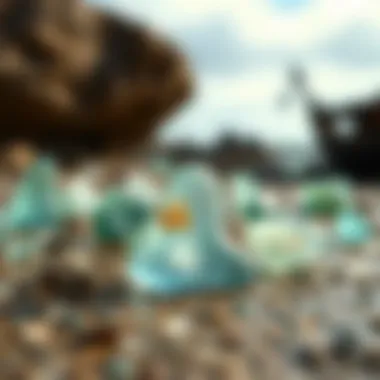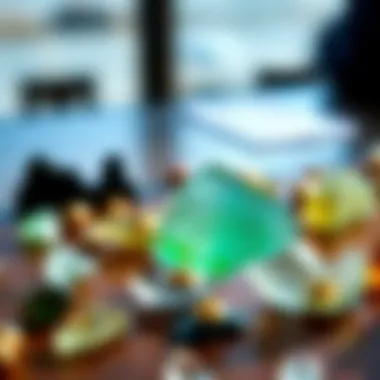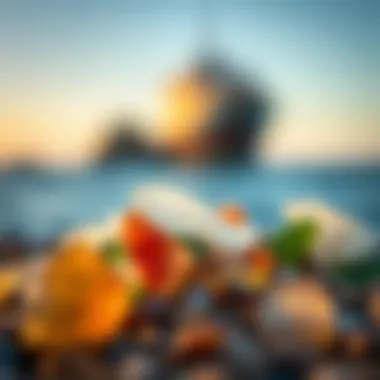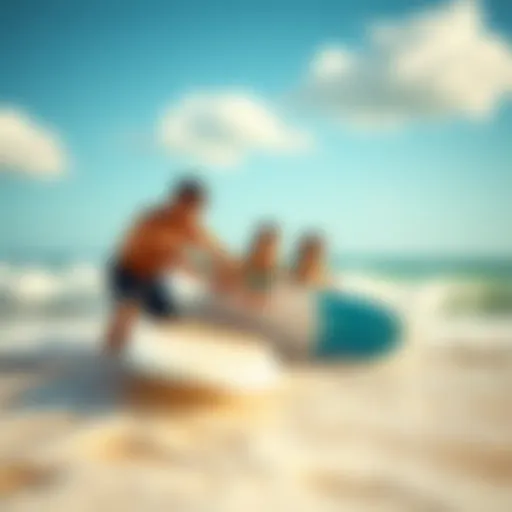Craftsmanship and Origins of Natural Sea Glass


Intro
Natural sea glass embodies a fascinating story, waiting to be discovered along the shores and rocky outcrops of our coastlines. Once a discarded shard, perhaps from a bottle or a windowpane, it transforms through the relentless action of waves and sand into a smooth, frosted piece of art. The journey of these pieces not only sheds light on the beauty derived from waste but also highlights a significant environmental narrative. In this article, we explore the roots of sea glass, the unique craftsmanship that brings it to life, and the broader implications surrounding its existence. Delving into the craft's relevance both artistically and ecologically allows us to appreciate its role in our ecosystem and offers insights into how we can be responsible stewards of this incredible resource.
The Journey of Sea Glass
Origins in Nature
Sea glass originates when man-made glass items break and are cast into the ocean. Over time, the fragments face incessant tumbling against rocks, sand, and surf, enhancing their texture and changing their appearance. Lasting anywhere from a few decades to many years, the process is not only natural but also crucial in helping us understand the impact of human consumption on marine environments. As it journeys through the water, beachgoers often intermingle with these pieces of treasure without realizing their profound narrative.
Significant Processes
The transformation of glass to sea glass involves various processes:
- Erosion: Waves and currents grind the fragments smoother.
- Tumbling: Beach conditions dictate the extent of the weathering; rougher environments yield unique shapes.
- Color Changes: Atlantic ocean currents typically enhance the rich hues, from vibrant greens to serene blues and soft whites.
Each piece earns its unique character, with glass that once sparkled in sunlight now exhibiting an alluring, softened glow, making it an artistic delight.
"Like forgotten memories washed ashore, sea glass narrates tales of where we’ve been and what we’ve left behind."
Crafting with Sea Glass
Creative Applications
As it stands, sea glass has garnered attention not only for its ecological value but also for its artistic potential. Here are some prevalent ways artisans repurpose sea glass:
- Jewelry Design: Adornments made of sea glass have become a popular trend, with many artists crafting distinctive necklaces, earrings, and bracelets tailored for diverse tastes.
- Home Decor: From colorful mosaic tile work to stunning sculptures, crafters have infused interiors with natural beauty, often telling a story with each piece.
- Functional Art: Unique items such as coasters, picture frames, and lampshades breathe new life into the discarded materials, showcasing creativity intertwined with sustainability.
Preserving Natural Habitats
Even with its allure, the practice around collecting sea glass raises discussions about ecological impact. Harvesting should be tempered with awareness:
- Respecting Local Rules: Many coastal areas have regulations on collection to protect habitats.
- Sustainable Gathering: For enthusiasts, collecting responsibly ensures that habitats remain undisrupted, preserving the delicate ecosystems that support marine life.
The duality of beauty and responsibility underlines the essence of natural sea glass. As collectors and crafters, the onus rests on us to reconcile our desire for these unique pieces with the duty to protect their origins.
The End
As we navigate through the waves of understanding regarding natural sea glass and its craft, it becomes evident that this unique material is indeed more than just beautiful fragments washed ashore. Its journey reflects both the history of human activity and our intricate relationship with nature. Embracing this eco-friendly resource not only enhances artistic expressions but also encourages mindfulness about our environmental footprints, pushing us towards a more sustainable future.
For further exploration on the topic of sea glass and its environmental significance, resources such as Wikipedia and Britannica provide valuable insights.
Understanding Natural Sea Glass
Natural sea glass holds a unique place in both nature and artistry, capturing the allure of the ocean and the subtle beauty of craftsmanship. Its formation reflects not just natural processes, but also the interactions of human activity and the marine environment. In this article, we will delve into the intricate journey of sea glass—from its biological roots to its artistic applications—understanding its multifaceted significance.
Exploring natural sea glass opens the door to discussions that transcend mere aesthetics. For those engaged in outdoor sports like surfing or paddleboarding, every piece of sea glass serves as a reminder of the ocean's diversity and the notion of recycling nature's treasures. Collecting sea glass can deepen the connection with the environment, blending enjoyment with sustainability. Moreover, the unique features of sea glass can enrich artistic expressions, making it an intriguing element for creators.
Definition and Properties
Natural sea glass is formed when glass fragments are continuously tumbled by ocean currents and the abrasive action of sand along the shore. This process can take many years, creating smooth, frosted pieces that often display a range of colors—green, brown, and clear predominating, with rarer hues like blue and purple occasionally found. Properties of sea glass vary, including:


- Texture: The surface can vary from smooth to more rustic, depending on how long it has been in the water.
- Color Variability: Color often arises from the original glass source, whether food containers, bottles, or other forms. The sun’s UV exposure can also affect the color depth over time.
- Shape: While naturally rounded and worn, the shapes can display unique characteristics based on the original item's design.
Sea glass not only speaks of time but also reflects the environmental changes it has undergone.
Historical Context and Significance
The essence of sea glass is steeped in rich history and cultural significance. Historically, pieces of glass discarded near shorelines were often considered a nuisance. However, over the decades, as environmental awareness grew, people began to appreciate these artifacts as both unique curiosities and sustainable materials. Gatherers would collect sea glass for personal enjoyment, art projects, or even jewelry making.
In particular, regions known for their coastline—such as the Pacific coasts of California or Oregon—have embraced sea glass culture. This cultural re-evaluation of waste transformed it from refuse to resource.
"Natural sea glass is not just a product of nature; it's a dialogue between mankind and the earth, showing how we, too, can be part of a larger ecological chain."
As we continue to refine our understanding of encompass ecological sustainability, the historical context of sea glass emphasizes ongoing conversations around waste management, recycling, and the importance of maintaining clean oceans. Each piece of sea glass collected carries with it a story that can connect individuals to broader environmental themes.
In summary, understanding natural sea glass offers a glimpse into the complexities of ecological relationships and human impact. It encourages mindfulness about our relationship with nature and reveals how something intentionally discarded can become an invaluable part of our cultural heritage.
The Formation Process of Sea Glass
Understanding how natural sea glass comes to be is crucial for anyone fascinated by this unique marine material. The formation process encompasses a blend of natural forces and time that reshape discarded glass into smooth, frosted gems. This section will explore the vital elements of erosion, ocean currents, and the timescale required for these transformations, thereby deepening our appreciation for sea glass as not just a pretty trinket but a product of nature’s artistry.
Erosion and Weathering Mechanisms
The journey of glass to becoming sea glass starts with erosion and weathering. Initially, discarded glass might be a jagged shard that could cut a foot or cause havoc on a beach. But nature, with its relentless wave action and environmental forces, begins to wear down those edges.
Through a process known as mechanical weathering, waves crash against the glass, abrading its surface. Sand, salt, and other debris carry in the tide act like nature’s sandpaper, gradually smoothing out sharp edges and creating a soft texture. This transformation is not instantaneous; rather, it is a slow dance of geological time.
For instance, imagine a colorful bottle lost to the ocean. Over time it undergoes countless interactions with sand particles and water, chipping away its surface, transforming it into a soft, translucent pebble-like form. The end product, when held in the palm, often showcases rounded corners and a tactile finish that are pleasing to touch.
"The beauty of natural sea glass lies not just in its color but in the story etched in its surface by the ocean's embrace."
Role of Ocean Currents and Tides
Ocean currents play a significant role in the formation of sea glass. They act as the highways of the sea, transporting materials across vast distances. Every time glass fragments are swept away by currents, they might encounter a different environment which further contributes to their weathering.
High and low tides also create cyclical patterns that bring fragments into contact with abrasive materials on the shoreline. Every ebb and flow contributes to changing not just the location of glass but also its texture and appearance. Some currents might push glass towards more active beaches where the wave action is stronger, increasing the efficiency of erosion. Conversely, glass can end up in calmer waters, where less change occurs, allowing it to retain more of its original shape but often leading to a longer transformation process.
Thus, navigating the currents is as much about time as it is about distance—some pieces may be tumbled and polished rapidly while others take a prolonged journey, illustrating the unpredictable nature of sea glass formation.
Timeframe of Transformation
When it comes to natural sea glass, time is not just a factor; it is an essential element. The transformation from sharp glass fragment to smooth sea glass can take anywhere from 5 to 50 years or more, depending on a myriad of factors including the initial size and type of glass, environmental conditions, and the intensity of wave action.
Within coastal areas, some glass pieces endure heavy storms or prolonged periods of consistent wave action, accelerating their transformation. Others, sheltered away, may linger for decades, contributing their stories of storms and sun to the collective history of the beach.
To put it simply, not all glass will become sea glass, as factors vary dramatically—only the best fit for nature’s alchemy will survive the test of time and tides.
In summary, the formation process of sea glass is a complex interplay of erosion, environmental forces, and time. It highlights how discarded objects can be reclaimed by nature, illustrating both the fragility and resilience of materials washed ashore. Thus, the next time you stumble upon these stunning artifacts, consider the journey they undertook to move from debris to dollar, transforming into a beautiful testament to nature’s craftsmanship.
Types of Natural Sea Glass
Understanding the various types of natural sea glass is crucial for those who appreciate its beauty and potential uses. Each type offers something unique, not just visually, but in how it can be collected, crafted, and incorporated into artistic endeavors. The intricacies of sea glass types shed light on its diverse origins, further enriching its story and enhancing its value.


Color Variations and Their Causes
The beauty of natural sea glass lies significantly in its color variations, which can range from deep cobalt blues to seaweed greens, clear whites, and even the rarest shades like pinks and ambers. These colors arise from different sources of glass interacting with environmental factors over time.
- Origins of Color: Different types of glass were manufactured for various purposes. For example, cobalt blue comes from glass used in old soda bottles, while pale green reveals its beginnings as a wine bottle. Likewise, clear glass may represent anything from a gin bottle to common household items.
- Environmental Influence: The conditions under which the glass is submerged play a vital role. For instance, prolonged exposure to sunlight can fade colors, while the minerals in the sand and water contribute to a glass's hues.
- Chemical Reactions: Over time, chemical reactions between the glass and surrounding seawater can alter the glass's properties, refining its texture and further changing its color.
This riot of colors not only attracts collectors but serves as a point of fascination for artists aiming to utilize these distinctive qualities in their work. The understanding of color variations opens avenues for both creative ventures as well as deeper appreciation for what occurs beneath the waves.
Texture and Form Factors
The texture and form of natural sea glass add another layer of intrigue when it comes to its craft applications. Each glass shard transforms under the relentless whispers of the ocean, shaped by time and tide.
- Smoothness: The waves roll the glass against pebbles and sand, smoothing sharp edges and creating a polished surface. Artisans often seek this smoothness for jewelry making, as it is pleasing to the touch and visually appealing.
- Nature of Shapes: Sea glass can be found in diverse shapes, from rounded stones to shards with unique edges. The variety in shapes allows for versatility in crafting - for instance, irregular pieces can become the centerpiece of a decorative art piece or a stunning pendant.
- Surface Characteristics: Some pieces may exhibit frost-like surfaces or nicks. These textures may appear as imperfections but often add character and intrigue to the glass, which can enhance the overall artistic appeal.
Exploring these elements gives crafters and collectors a deeper understanding of the careful balance between nature and art, prompting a conversation about the journey of sea glass from the ocean to the artist's table. As we consider these factors, we gain insights into the interconnectedness of sustainability and aesthetics, reinforcing the importance of preserving these natural wonders.
"Every piece of sea glass tells a story, shaped by forces we can only begin to comprehend."
By embracing the types of sea glass, we celebrate its ecological significance and artistic possibilities, while underscoring the responsibility we all have to protect the sources from which these treasures come.
Ecological Impact of Sea Glass
Natural sea glass does more than just catch the eye with its colorful hues; it plays an important role in marine ecosystems. Understanding this impact is essential for those who appreciate the beauty of the ocean, including surfers, paddleboarders, and kitesurfers. The ecological footprint of sea glass is multifaceted—intertwined with beneficial interactions, environmental considerations, and the delicate balance required to maintain coastal habitats.
Role in Marine Ecosystems
Natural sea glass creates more than just embellishments for jewelry and decor—it spurs diverse benefits within marine environments. Over time, as glass fragments erode, these smooth stones become habitats for small marine organisms, such as barnacles and algae. Placed thoughtfully within beach ecosystems, sea glass can enhance the biodiversity of a given habitat.
Some key elements include:
- Microhabitats: The textured surface of sea glass acts like a natural reef, offering a settlement point for various sea life. These small homes contribute to the overall health of the ecosystem.
- Food Source: Algae and other small organisms that thrive on sea glass can, in turn, become food for larger marine creatures, reinforcing the food chain.
- Aesthetic Appeal: For surfers and beachgoers, vibrant sea glass scattered along shorelines adds visual charm, potentially attracting tourism and supporting local economies.
"The presence of sea glass can lure curious beachgoers, ensuring minimal disruption to their natural surroundings while optimizing the environment they cherish."
Environmental Considerations
While sea glass has ecological benefits, it’s crucial to weigh these against environmental considerations that accompany its collection. Improper harvesting can lead to disruptions in local marine habitats.
Some critical points to acknowledge are:
- Regulations and Restrictions: Many coastal areas impose regulations on collecting sea glass to protect marine life. Adhering to local laws is vital for maintaining healthy ecosystems.
- Impact of Overcollection: Gathering too much sea glass can lead to the depletion of local sources, fundamentally altering the community of organisms that rely on it for survival.
- Educational Value: By recognizing the ecological significance of sea glass, enthusiasts can foster a deeper appreciation for marine environments. Knowledge leads to responsible actions, ensuring sustainability for future generations.
Crafting with Natural Sea Glass
Crafting with natural sea glass offers a fascinating intersection of nature and artistry, allowing creators to explore the beauty of this unique material while promoting environmental consciousness. Not merely a passive finding from the beach, natural sea glass has found its way into numerous artistic ventures, from jewelry-making to home decor. Its usage underscores a deeper relationship with the environment, encouraging the idea of recycling materials that would otherwise contribute to pollution.
The allure of crafting with sea glass lies not only in its aesthetic appeal but also in the stories each piece carries—each fragment holds a fragment of history, having traveled through waves, tides, and time. This crafting process serves as a celebration of imperfection; no two pieces are alike, and their unique shapes, colors, and textures contribute to the organic charm of the created art. Furthermore, the eco-friendly angle provides a compelling incentive for artisans and hobbyists alike, driving a commitment to sustainable practices that respect and protect our coastal environments.
Techniques and Materials
When diving into the realm of crafting with natural sea glass, knowledge of suitable techniques and materials is essential. Many artists utilize a variety of tools and methods to transform raw pieces into captivating works of art. Commonly employed techniques include:


- Wire Wrapping: This popular technique involves wrapping the sea glass with metal wire, allowing the artist to create unique jewelry pieces such as pendants and earrings. Wire wrapping elevates the natural beauty of the glass while ensuring its security.
- Soldering: For more advanced users, soldering sea glass can enhance its integration into various forms, like larger frames or mosaics. With skillful manipulation of heat and materials, artisans can create seamless connections between glass and other elements like wood or metal.
- Drilling: Creating holes in sea glass opens up avenues for stringing pieces together or attaching them to other decorative elements. Choosing the right drill bit and approach, artists can preserve the integrity of their materials while enhancing their designs.
The materials used alongside sea glass are just as important. Many craftspeople opt for sustainable resources. This may involve repurposing old jewelry parts, using recycled metals for wire, or engaging with sustainable wood when creating frames. Many emphasize the need to avoid new plastic components, reflecting a commitment to ecological mindfulness.
Artistic Applications
The artistic applications of natural sea glass are as varied as they are inspiring. This unique material can be transformed into:
- Jewelry: A prime example includes necklaces, bracelets, and earrings. Artisans have taken to combining multiple pieces of varying colors and shapes to craft eye-catching designs that tell a story.
- Home Decor: From lampshades to candle holders, sea glass has become an increasingly popular element in interiors. Its ability to catch and refract light adds a touch of coastal elegance.
- Mosaics: Sea glass can be incorporated into mosaic art, allowing for larger installations that celebrate the organic shapes and colors of the glass. Individual pieces may be arranged into beautiful murals or used to embellish furniture.
"Crafting with natural sea glass isn't just about making art; it's about reconnecting with our environment in a creative and meaningful way."
For more insights into the world of natural sea glass crafting, check resources like Wikipedia or Britannica.
Preservation and Collection Practices
The act of collecting natural sea glass can be as fulfilling as it is precarious. As we admire the beauty and uniqueness of these small, colored treasures, there are vital considerations that collectors must keep in mind to ensure the preservation of this rare resource. The balance between enjoying the hunt and conserving the environment is delicate and essential.
When we talk about preservation, it does not merely entail keeping the glass intact; it refers to maintaining the very ecosystems that create these items. As collectors, we must acknowledge our impact on coastal environments. Collecting sea glass irresponsibly could disrupt local habitats and potentially endanger other marine gifts, like shellfish or native plants.
Ethical Guidelines for Collectors
Adhering to ethical guidelines is an invaluable practice for anyone venturing into the realm of sea glass collection. Here are some key principles to keep in mind:
- Respect Nature: Always leave behind a portion of what you find. The local environment relies on these fragments for its ongoing beauty and habitat complexity.
- Avoid Protected Areas: Coastal regions designated as conservation areas often have rules against collection. Always be aware of local regulations, respecting boundaries even if the temptation is strong.
- Educate Yourself: Understand the marine ecosystems in your area. This knowledge can help you develop a deeper appreciation for the materials you find.
"Natural sea glass transcends mere aesthetics; it's a narrative of resilience from the depths of the ocean."
Impact of Collection on Coastal Ecosystems
The relationship between collectors and coastal ecosystems is reciprocal, though it can easily tip into imbalance. Sea glass doesn’t appear by magic. It’s the byproduct of discarded glass subjected to years of turbulent waves and weather, acting as an integral part of marine habitats. When we collect, we risk disturbing the very processes that generate these charming artifacts.
- Fragmentation of Marine Life: The ocean floor houses a multitude of organisms relying on rocks and debris for shelter and sustenance. Picking up a piece of sea glass could mean losing part of that delicate balance.
- Shifting Sediment Patterns: Overzealous collection can lead to significant changes in coastal sediment patterns. In areas with heavy foot traffic, sea glass might become less prevalent due to constant harvesting, undermining the ecosystem's natural restorative processes.
- Awareness and Responsibility: Collectors should strive to embrace a mindset of stewardship. The more mindful we are, the better we can enjoy our pursuits while simultaneously safeguarding the wonders of our coastlines.
Future of Natural Sea Glass
As we look toward the horizon, the future of natural sea glass stands as a testament to the ever-evolving relationship between humanity and nature. With more individuals becoming environmentally conscious, the importance of preserving this unique resource has gained traction. Natural sea glass serves not only as an artist's medium but also as a symbol of sustainability and ecological responsibility. The decisions we make today regarding its collection and use will significantly shape the environments where this treasure forms.
Market Trends and Demand
The rising trend of eco-friendly materials has sparked interest in natural sea glass, driving a noticeable demand for it in various markets. Artists and craft enthusiasts are increasingly drawn to its aesthetic appeal, often using it in jewelry and home decor. With consumers leaning towards sustainable choices, products featuring sea glass stand out in bustling marketplaces.
Recent studies show that sales of sea glass items have increased nearly 30% over the last five years. This surge indicates a broader shift towards materials that tell a story and connect us to our environment. Manufacturers and artisans alike see the potential in both the market for finished goods and raw materials, suggesting a bright future ahead.
Natural sea glass is not only a cherished item for personal use but also a collectible, with certain pieces fetching prices in the hundreds of dollars at specialty auctions. Social media platforms, especially Pinterest and Instagram, have facilitated the showcasing of unique sea glass art, creating communities of enthusiasts eager to share their finds and creations. As these networks grow, so does interest in the stories behind each piece, emphasizing the relationship between craftsmanship and sustainability.
Sustainable Practices and Innovations
In the quest for durability and environmental harmony, innovation is key. Sustainable practices related to the collection and utilization of natural sea glass are gaining momentum. For instance, several organizations are developing guidelines for ethically harvesting sea glass. This aims to balance the desires of collectors with the need to protect marine ecosystems.
Techniques have also evolved in the crafting process, allowing artisans to work with less waste. By employing water-safe adhesives and eco-friendly finishes, creators are ensuring that their artistic endeavors incorporate respect for the environment. Additionally, some forward-thinking companies have begun using not only sea glass but also recycled glass in their products, further reducing the carbon footprint associated with traditional glass manufacturing.
Practices like educating communities about the ecological impacts of poor collection methods are also crucial. Engaging with coastal communities ensures that there’s a collective understanding of the importance of preserving habitats where sea glass forms. This communal approach fosters a sense of ownership over local resources, which is vital for the future sustainability of natural sea glass.
"Ultimately, the future of natural sea glass hinges on our ability to adapt and respect the ecosystems that produce it."
While the charm of sea glass captivates many, we must remember its origins. By focusing on sustainable innovations and ethical practices, we can honor the delicate balance between human creativity and our natural world. As we navigate this future, it's crucial to embrace both the artistry found in sea glass and the responsibility we hold to protect it.



